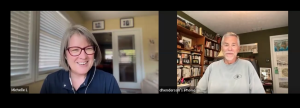I am so glad that the Apostle John felt moved by the Spirit and his memories to write another gospel. Even though the first three are a blessing, they cover pretty much the same material (called the Synoptic Gospels because they “see together” with a common sight, syn-optic). John, on the other hand, looks at our Lord’s story from a different perspective, a perspective that offers new insights on what we read in the first three gospels. For instance, let’s consider the twelve disciples for a moment.
As the synoptic gospel Luke tells it in chapter 5, one would assume that Jesus walked up to Peter, called him to follow and so Peter, Andrew, James and John left their boats and business behind to walk with Jesus. While this is exactly what happened, John provides more of the backstory.

Right after the amazing prologue (we’ll save that for another day), the Apostle John begins his gospel with the testimony of the prophet John. The other gospels also confirm that Prophet John had disciples, so when Prophet John pointed to Jesus and declared that this was “the Lamb of God who takes away the sin of the world” we can safely assume that his disciples heard him. We can also safely assume that the disciples heard Prophet John say other things about Jesus and that John’s teaching spanned several days (John 1:32-34). This teaching likely energized those who had aligned themselves with this newly emerged and controversial prophet (see Matthew 3:1-12 and imagine what this sort of teaching did to stir the imaginations of those who followed).
John 1:35-50 provides some interesting details for us to consider. Upon hearing John’s repeated testimony about Jesus, two of John’s disciples broke off and began following Jesus as He walked. One of them was named Andrew. Andrew became so convinced that Jesus was the long-awaited Messiah that the first thing he did was to find his brother, Peter, tell him the news and introduce him to Jesus. The fact that this is the first thing Andrew did suggests that the topic of the coming Messiah was one that he and Peter had discussed before. Additionally, the fact that they were at Bethany on the east side of the Jordan river means that Andrew did not run home to find Peter…Peter was already there, listening to John too!
The next day we learn that Philip (who also became one of Jesus’ disciples), Andrew and Peter, were all from the same home town, Bethsaida. The name of this small village means “house of fishing” and its location on the north shore of the Sea of Galilee lends support that the name likely identified the primary industry. Archaeological ruins suggest that this village had a population of only three to four hundred people. In a tight-knit, small community it is probable that Andrew and Peter used to play with Philip when they were boys.
Philip went and told his friend, Nathanael, that they found the one spoken of by Moses and the prophets (suggesting that this had been a conversation for them as well). John 21:2 tells us that Nathanael was from Cana in Galilee. It is possible that Philip told Nathanael this news after they arrived in Cana, which would explain why Jesus and His disciples were part of the very next story in John 2. Down through the years, scholars have debated whether or not Nathanael was one of the 12. If he was, he likely went by the name of Bartholomew. If he was not, then we know that he was one of the disciples who followed Jesus from the very beginning (or really, really close to the very beginning, Acts 1:21-22) for he is listed as being a witness to the resurrection (John 21:2).
Let’s review what we know as fact: Andrew was a disciple of the prophet John. Andrew and Peter were brothers who were from the same small town as Philip. Philip knew Nathanael of Cana. Let’s now speculate a little. John 1:35 lists an unnamed disciple who initially followed Jesus with Andrew. Based on the fact that the gospel writer John was known to veil his identity (calling himself the disciple whom Jesus loved and speaking of himself as “the man who saw it,” see 19:26, 35), many have concluded that this unnamed disciple is actually the Apostle John, this gospel’s author. This view is strengthened by the fact that John already knew Andrew because John and his brother James, had a fishing partnership with Andrew and Peter (which also suggests that James and John may have been from Bethsaida as well).
With all this as background, take two minutes to read Luke 5:1-11 again. For me, knowing some of the backstory makes the disciples more human, more like me. It appears that Luke 5 is not their first encounter with Jesus. They knew Him from before and had been “following” Him in some way. Yet, when we get to Luke 5 we see that the time had come for a new level of trust and action. “So they pulled their boats up to the shore, left everything and followed Him.” This significant commitment developed over time and was strengthened by the bonds of trusted community. And to think it all began with the simple invitation from one friend to another. “Come and see.” I wonder, where did it begin for you? Have you reached the point where you can walk away from your “boats” to follow Jesus in a more radical way? Where are you and I hearing His invitation today?
The Lord has some rich treasures to share with us from John’s account. I look forward to finding them with you along the way.
I offer a quick reminder that I will be out next week on a prayer retreat and so will not post on September 18. My next post will be September 25. Thanks for your prayers as I enter this renewal leave!

Rob






